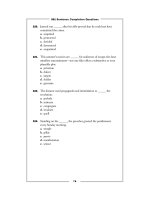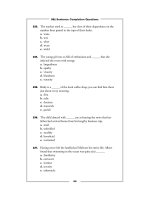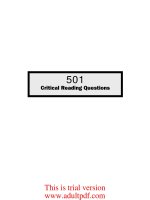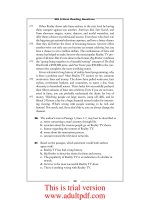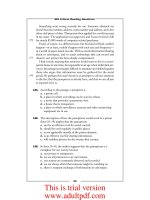501 critical reading questions p7
Bạn đang xem bản rút gọn của tài liệu. Xem và tải ngay bản đầy đủ của tài liệu tại đây (133.89 KB, 15 trang )
48.
49.
50.
51.
52.
53.
54.
55.
56.
57.
58.
intended to influence decisions or actions. Choice b is the
only selection that implies action.
e. The passage describes the decade as one in which spending
won out over prudent measures like saving (lines 31–32). The
wild stock market speculation described in lines 35–37 is
another example of the exuberant decade.
b. The analogy depicts the stock market crash of 1929 as a
weakening agent to the economy (the way a stressful event
may weaken the body’s resistance to illness), not as the sole
cause of the depression.
d. Lines 56–59 state that the New Deal expanded tfte role of tfte
central government in regulating tfte economy and creating social
assistance pro- grams. Choices b and c are incorrect and choices a
and e require an opinion; the author does not offer his or her
viewpoint about the New Deal measures.
c. The Lewis and Clark expedition did not have a military goal
and did not have any violent encounters except the one
described in lines 41–43.
b. Jefferson and his representatives wanted Native Americans to
acknowledge American sovereignty and to see themselves as
chil- dren to his role as their “father.”
c. One meaning of protocol is a code that demands strict
adherence to etiquette.
d. The passage states that Lewis and Clark sougftt to impose tfteir
own notions of ftierarcfty on Native Americans by “making
cftiefs” witft medals, printed certificates, and gifts (lines 30–33).
c. By placing a peace medal around the neck of a man killed
by the expedition makes an ironic statement about the
meaning of “peace.”
b. To the Plains Native Americans, the pipe ceremony meant that
those who participated accepted sacred obligations to sftare wealtft, aid
in war, and revenge injustice (lines 50–51). The passage suggests
that Lewis and Clark most likely did not understand the
significance of the ceremony.
e. One meaning of adopt is to take by choice into a relationship.
In this context, adopt has another meaning: to take up and
practice or use.
e. By giving manufactured goods to Native Americans, Lewis and
Clark were promoting Euro-American culture. Jefferson hoped
that these free samples would introduce tfte Native Americans
to mecftanized agriculture as part of ftis plan to “civilize and
instruct” tftem (lines 58–61).
57
501 Critical Reading Questions
59.
60.
61.
62.
63.
64.
65.
66.
67.
68.
69.
70.
71.
a. The passage compares different abstract principles, or
organizing principles of Euro-American society versus that of
tribal societies. For example, it explores the principles of
hierarchy and kinship.
b. Choice a is too general to be the primary purpose of the
passage, whereas choices c and e are too specific. Choice d is
not sup- ported by the passage.
c. Beecher Hooker invokes the Constitution (line 1) and recites
the preamble (lines 9–13) in order to appeal to and persuade
her audience.
a. Beecher Hooker plays on the two meanings suggested by the
phrase learn it by fteart as well as by ftead. She asks her
audience to not only memorize the Constitution’s preamble,
but to use both emotion and intellect to understand its
meaning.
e. One meaning of anxious is extreme uneasiness or dread. An
alter- native meaning applies to this context—that of ardently
or earnestly wishing.
c. Passage 1 argues that the foremothers of the nation were
patri- otic and did tfteir full sftare (line 30) of contributing to
the early republic.
b. The passage anticipates the arguments of those in favor
of women’s right to vote and refutes them.
c. Novel means new and not resembling something known or
used in the past. Choice b, original, could fit this definition
but its connotation is too positive for the context.
a. Passage 2 describes woman-suffrage societies as tftorougftly organized,
witft active and zealous managers (lines 14–15). Choice b, courageous, is too positive for the context of the passage.
a. Passage 2 states that every one . . . knows tftat witftout female
suf- frage, legislation for years ftas improved and is still improving
tfte con- dition of women (lines 24–27).
d. Passage 2 emphasizes how well women are served by judges
in line 35. Passage 1 does not refer to this issue at all.
b. Passage 1 describes men as figftters by nature (line 37), but not
women. Passage 2 describes women as incapable of performing
mil- itary duty (lines 4–5).
d. Passage 1 addresses its audience in the second person,
whereas Passage 2 does not. Passage 1 also refers to its
audience as friends (line 14) and brotfters (line 18).
58
3
Ar ts and Humanities
Questions 113–116 are based on the following
passage.
The following paragraph details the design of New York City’s Central Park.
(1)
(5)
(10)
Although it is called Central Park, New York City’s great green
space has no “center”—no formal walkway down the middle of
the park, no central monument or body of water, no single
orienting feature. The paths wind, the landscape constantly shifts
and changes, the sections spill into one another in a seemingly
random manner. But this “decen- tering” was precisely the intent of
the park’s innovative design. Made to look as natural as possible,
Frederick Law Olmsted’s 1858 plan for Cen- tral Park had as its
main goal the creation of a democratic playground— a place with
many centers to reflect the multiplicity of its uses and users.
Olmsted designed the park to allow interaction among the various
members of society, without giving preference to one group or
class. Thus, Olmsted’s ideal of a “commonplace civilization” could be
realized.
72.
In lines 3–5, the author describes specific park features in order to
a. present both sides of an argument.
b. suggest the organization of the rest of the passage.
c. provide evidence that the park has no center.
d. demonstrate how large the park is.
e. show how well the author knows the park.
59
501 Critical Reading Questions
73.
The main idea of this passage is that
a. New York City is a democratic city.
b. Olmsted was a brilliant designer.
c. More parks should be designed without centers.
d. Central Park is used by many people for many
different purposes.
e. Central Park is democratic by design.
74.
The passage suggests that Olmsted’s design
a. was like most other parks being designed at the time.
b. was radically different from other park designs.
c. was initially very unpopular with New Yorkers.
d. was inspired by similar parks in Europe.
e. did not succeed in creating a democratic playground.
75.
The word commonplace as used in line 12 most nearly means
a. inclusive.
b. ordinary.
c. mediocre.
d. normal.
e. trite.
Questions 117–120 are based on the following
passage.
In this excerpt from Book One of his Nicomachean Ethics, Aristotle
expands his definitions of “good” and “happiness.”
(1)
(5)
(10)
(15)
Good things are commonly divided into three classes: (1)
external goods, (2) goods of the soul, and (3) goods of the body.
Of these, we call the goods pertaining to the soul goods in the
highest and fullest sense. But in speaking of “soul,” we refer to
our soul’s actions and activities. Thus, our definition [of good]
tallies with this opinion which has been current for a long time
and to which philosophers subscribe. We are also right in
defining the end as consisting of actions and activ- ities; for in
this way the end is included among the goods of the soul and not
among external goods.
Also the view that a happy man lives well and fares well fits in
with our definition: for we have all but defined happiness as a
kind of good life and well-being.
Moreover, the characteristics which one looks for in happiness
are all included in our definition. For some people think that
happiness is a virtue, others that it is practical wisdom, others
that it is some kind
60
501 Critical Reading Questions
of theoretical wisdom; others again believe it to be all or some of
these accompanied by, or not devoid of, pleasure; and some
people also include external prosperity in its definition.
76.
According to the passage, the greatest goods are those that
a. are theoretical.
b. are spiritual.
c. are intellectual.
d. create happiness.
e. create prosperity.
77.
The word tallies in line 5 means
a. keeps count.
b. records.
c. labels.
d. corresponds.
e. scores.
78.
The author’s definition of happiness in lines 11–12 is related to
the definition of good in that
a. living a good life will bring you happiness.
b. happiness is the same as goodness.
c. happiness is often sacrificed to attain the good.
d. all things that create happiness are good things.
e. happiness is a virtue.
79.
In lines 13–18, the author’s main purpose is to
a. show that different people have different definitions
of happiness.
b. define virtue.
c. prove that his definition of happiness is valid.
d. explain the relationship between happiness and goodness.
e. provide guidelines for good behavior.
Questions 121–125 are based on the following
passage.
The following passage describes the ethical theory of utilitarianism.
(1)
If you have ever made a list of pros and cons to help you make a
deci- sion, you have used the utilitarian method of moral reasoning.
One of the main ethical theories, utilitarianism posits that the key to
deciding what makes an act morally right or wrong is its
consequences.
61
501 Critical Reading Questions
(5)
(10)
(15)
(20)
Whether our intentions are good or bad is irrelevant; what
matters is whether the result of our actions is good or bad. To
utilitarians, hap- piness is the ultimate goal of human beings and
the highest moral good. Thus, if there is great unhappiness
because of an act, then that action can be said to be morally
wrong. If, on the other hand, there is great happiness because of
an action, then that act can be said to be morally right.
Utilitarians believe that we should carefully weigh the
potential consequences of an action before we take it. Will the act
lead to things that will make us, or others, happy? Will it make
us, or others, unhappy? According to utilitarians, we should choose
to do that which creates the greatest amount of good (happiness) for
the greatest num- ber of people. This can be difficult to determine,
though, because sometimes an act can create short-term
happiness but misery in the long term. Another problematic
aspect of utilitarianism is that it deems it acceptable—indeed, even
necessary—to use another person as a means to an end and
sacrifice the happiness of one or a few for the happiness of many.
80.
In lines 1–2, the author refers to a list of pros and cons in order to
a. show that there are both positive and negative
aspects of utilitarianism.
b. suggest that making a list of pros and cons is not an
effective way to make a decision.
c. emphasize that utilitarians consider both the good and the
bad before making a decision.
d. indicate that readers will learn how to make decisions
using pro/con lists.
e. show readers that they are probably already familiar with
the principles of utilitarian reasoning.
81.
The word posits in line 3 means
a. agrees.
b. asserts.
c. places.
d. chooses.
e. denies.
62
501 Critical Reading Questions
82.
According to the definition of utilitarianism in lines 3–11,
stealing bread to feed hungry children would be
a. morally right because it has good intentions.
b. morally wrong because of it violates another’s rights.
c. morally right because it has positive consequences.
d. morally wrong because stealing is illegal.
e. neither morally right nor wrong; a neutral action.
83.
According to the utilitarian principles described in lines 13–19,
we should
a. do what will bring us the most happiness.
b. always think of others first.
c. make our intentions clear to others.
d. do what will make the most people the most happy.
e. avoid things that will make us unhappy.
84.
In lines 19–22, the author’s purpose is to show that
a. using utilitarianism to make a moral decision is not always easy.
b. sacrifice is necessary in life.
c. long-term consequences are more important than shortterm consequences.
d. a pro/con list is the most effective technique for making
an important decision.
e. great good often comes at a great price.
Questions 126–133 are based on the following
passage.
Written by John Henry Newman in 1852, the following passage presents
Newman’s idea of the purpose and benefits of a university education.
(1)
(5)
(10)
I have said that all branches of knowledge are connected
together, because the subject-matter of knowledge is intimately
united in itself [ . . . ]. Hence it is that the Sciences, into which our
knowledge may be said to be cast, have multiple bearings on one
another, and an inter- nal sympathy, and admit, or rather demand,
comparison and adjust- ment. They complete, correct, and balance
each other. This consideration, if well-founded, must be taken
into account, not only as regards the attainment of truth, which is
their common end, but as regards the influence which they excise
upon those whose education
consists in the study of them. I have already said, that to give
undue prominence to one is to be unjust to another; to neglect or
supersede these is to divert those from their proper object. It is to
unsettle the
63
501 Critical Reading Questions
(15)
(20)
(25)
(30)
(35)
(40)
(45)
(50)
boundary lines between science and science, to disturb their action,
to destroy the harmony which binds them together. Such a
proceeding will have a corresponding effect when introduced into a
place of edu- cation. There is no science but tells a different tale,
when viewed as a portion of a whole, from what it is likely to
suggest when taken by itself, without the safeguard, as I may call
it, of others.
Let me make use of an illustration. In the combination of
colors, very different effects are produced by a difference in their
selection and juxtaposition; red, green, and white, change their
shades, accord- ing to the contrast to which they are submitted.
And, in like manner, the drift and meaning of a branch of
knowledge varies with the com- pany in which it is introduced to
the student. If his reading is confined simply to one subject,
however such division of labor may favor the advancement of a
particular pursuit, a point into which I do not here enter,
certainly it has a tendency to contract his mind. If it is incorporated with others, it depends on those others as to the kind of
influ- ence that it exerts upon him. Thus the Classics, which in
England are the means of refining the taste, have in France
subserved the spread of revolutionary and deistical doctrines. [ . .
. .] In a like manner, I sup- pose, Arcesilas would not have handled
logic as Aristotle, nor Aristo- tle have criticized poets as Plato; yet
reasoning and poetry are subject to scientific rules.
It is a great point then to enlarge the range of studies which a
Uni- versity professes, even for the sake of the students; and,
though they cannot pursue every subject which is open to them,
they will be the gainers by living among those and under those
who represent the whole circle. This I conceive to be the
advantage of a seat of univer- sal learning, considered as a place
of education. An assemblage of learned men, zealous for their
own sciences, and rivals of each other, are brought, by familiar
intercourse and for the sake of intellectual peace, to adjust
together the claims and relations of their respective subjects of
investigation. They learn to respect, to consult, to aid each other.
Thus is created a pure and clear atmosphere of thought, which
the student also breathes, though in his own case he only pursues a
few sciences out of the multitude. He profits by an intellectual
tradition, which is independent of particular teachers, which
guides him in his choice of subjects, and duly interprets for him
those which he chooses. He apprehends the great outlines of
knowledge, the principles on which it rests, the scale of its parts,
its lights and its shades, its great points and its little, as he
otherwise cannot apprehend them. Hence it is that his education
is called “Liberal.” A habit of mind is formed which lasts
t
hrough life, of which the attributes are, freedom, equi-
64
501 Critical Reading Questions
(55)
tableness, calmness, moderation, and wisdom; or what in a former
dis- course I have ventured to call a philosophical habit. This
then I would assign as the special fruit of the education furnished at
a University, as contrasted with other places of teaching or modes
of teaching. This is the main purpose of a University in its
treatment of its students.
85.
The main idea of the first paragraph (lines 1–18) is that
a. each science should be studied independently.
b. the sciences are interrelated.
c. the boundary lines between each of the sciences should
be clearer.
d. some sciences are unduly given more emphasis than others
at the university level.
e. it is difficult to attain a proper balance among the sciences.
86.
By tfte Sciences (line 3), the author means
a. the physical sciences only.
b. the social sciences only.
c. the physical and social sciences.
d. all branches of knowledge, including the physical and
social sciences and the humanities.
e. educational methodologies.
87.
The word excise in line 9 most nearly means
a. remove.
b. cut.
c. impose.
d. arrange.
e. compete.
88.
By using the word safeguard in line 18, the author suggests that
a. it is dangerous to limit one’s education to one field or area
of specialization.
b. it is not safe to study the sciences.
c. the more one knows, the safer one will feel.
d. one should choose a second area of specialization as a
backup in case the first does not work out.
e. each science has its own specific safety guidelines.
65
501 Critical Reading Questions
89.
The purpose of the second paragraph (lines 19–34) is to
a. introduce a new idea.
b. develop the idea presented in the previous paragraph.
c. state the main idea of the passage.
d. present an alternative point of view.
e. compare and contrast different branches of knowledge.
90.
The word appreftends as used in lines 50 and 52 means
a. understands.
b. captures.
c. fears.
d. believes.
e. contains.
91.
Which of the following best describes the author’s idea of a liberal
education?
a. in-depth specialization in one area.
b. free education for all.
c. a broad scope of knowledge in several disciplines.
d. training for a scientific career.
e. an emphasis on the arts rather than the sciences.
92.
The author believes that a university should
I. have faculty representing a wide range of subjects and
philosophies
II. teach students how to see the relationships among ideas
III. teach students to understand and respect other points of view
IV. teach students liberal rather than conservative ideals
a. I and II only
b. I, II, and III
c. I and IV
d. IV only
e. all of the above
Questions 134–141 are based on the following
passage.
In this passage, the author discusses the problem of maintaining privacy in our
high-tech society.
(1)
A recent New York Times “House and Home” article featured the story of a
man who lives in a glass house. Every wall in his home is trans- parent;
he has no walls to hide behind, not even in the bathroom. Of


